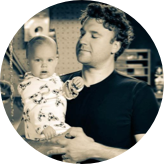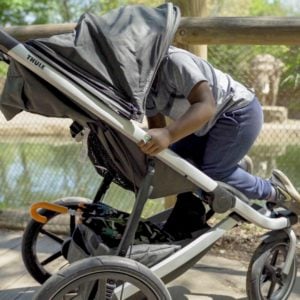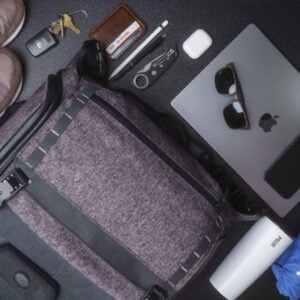We’re at it again with another sweet, sweet baby monitor review. (Sorry about that).
The full review’s below, here’s our video take:
From the first time you look at it, you know the Lollipop camera will be different. It looks, well, fun. Part of a family of video baby monitors that operate through WiFi to use your phone or tablet as a parent unit, it looks to set itself apart from competitors like the Nanit Plus and Cocoon Cam through design.
Does it accomplish that? We spent a few months with the camera and app to find out. Read on …
Please note: we received a free Lollipop Cam from the manufacturer. We do not guarantee positive reviews in exchange for free products, and always disclose free products received. You can read more about our policies here. Also, we are a participant in the Amazon Services LLC Associates Program, an affiliate advertising program designed to provide a means for us to earn fees by linking to Amazon.com and affiliated sites.
An in-depth review of the Lollipop Baby Monitor
We left nothing to chance. John and his team (ie his kids) worked tirelessly to bring you everything you need to know. Did that include John stealing a few Lollipops from his kids? Maybe. But we’re here for a review of the Lollipop baby monitor, of course – one of the most interesting devices that have come across the Fathercraft desk in a while.
Below, you’ll find (hopefully) everything you need to know about the Lollipop baby monitor. We’ll discuss what’s in the box, what picture quality you can expect, how to mount the camera (this one was fun), how the app works, and what subscription may work for you.
What, exactly, is a Lollipop?
Well, for starters, it’s clear where this baby monitor got its name from. The camera looks like a Lollipop, thanks to its distinctive tail that will be used for mounting it in one of five ways. After staring at this thing for so long, we noticed another thing it looked like too, but, hey, get your mind out of the gutter. It’s designed and manufactured in Taiwan, “for parents from parents” who are worriers and are looking for peace of mind, according to the manufacturer.
In the rush of new, smart baby monitors hitting the market (all of our baby monitor reviews are here), Lollipop wants to set itself apart with two features: its look and its price. Essentially, the company is making a bet that budget-conscious parents will be intrigued enough by the fun design to give it a shot, then impressed enough by the features to stick around.
Unlike some competitors like the Nanit, the company does not bill itself as an expert who will improve your child’s health. It’s simple and intuitive enough to just take the basic concept, making sure you know what your little one is doing at night, into the digital age.
Does it accomplish that goal? Mostly. Let’s dig in for more details.
What’s in the box?
Unboxing should be fun, right? That’s exactly what the makers of the Lollipop thought. When you first open it, you get a close look at that fun stem design of the camera itself. Remove that, and you get your typical array of power cords, power adaptor, and three cord guards (this last set of items is particularly important if you’re going to mount the Lollipop on or near your child’s crib: they prevent a baby from grabbing the cords and risking choking by getting cords wrapped around her neck. This can and does happen, so do pay attention.

Also in the box is everything you need to mount the camera. Let’s take a closer look at the Lollipop and its mounting options.
The Lollipop camera (child unit)
The Lollipop itself obviously has a unique look, which is directly connected to the mounting options we’ll discuss below. But what’s on the matters, right? In this case, that’s a 720p HD camera, thanks to a 1/3-inch 1.27-megapixel Sony IMX.225 CMOS sensor. A speaker plays white noise and helps you talk back to your child when you need to do some remote calming.

Camera positioning
Unlike some competitors like the Cocoon Cam, the Lollipop doesn’t need to be in a specific position to function properly. Its relatively wide 128-degree field of vision gives you several options, from the crib to the wall and the bookshelf, that all allow for a clear view of your little one. It’s all up to you and your preference.
Image quality
The camera’s 720p picture quality is good, but not great. More expensive competitors like the Miku Cam have a clearer picture, but it’s good enough to see everything you need to see.

Where the Lollipop shines is in its night vision. It has two different night vision infrared settings, depending on how far or close the monitor is to your baby. It switches between the two automatically, so you never have to worry about finding the right setting and can always see your little one clearly.

Mounting the Lollipop Cam
Time to get creative! That might not be the feeling you expect when you first take the Lollipop out of the box, but that long tail allows you to set it up in five different ways:
- A crib mount, which attaches the camera by twisting around the crib rail using the included cord guards.
- A bond mount, in which you use the included plastic connector to wrap the tail around the crib with a bit more security.
- A surface mount, twisting the tail into a kind of stand to stand it up on a bookshelf or table.
- A wall mount, which requires some screws in the wall. The horns on the mount in the box are for the tail to wrap around.
- A roll mount, which means twisting the tail around a thing, sturdy piece multiple times.
Which of these works best? The crib and bond mount are dangerous because they might be within reach of your child, especially if it’s older than a few months. Wall mounting works well but is pretty much permanent. Surface mounting sounds better in theory; in our tests, the camera didn’t really want to stand upright and kept falling.

That leaves us with roll mounting, which can actually work well if you find something to wrap around. Our tip: find a sturdy tablet or lampstand, then wrap the tail around it and position it close to the crib. You get the bird’s eye view and close proximity, without getting the camera or cords too close for comfort.
The Lollipop baby monitor app (parent unit)
Like other baby monitors in this category, the parent unit for the camera is an app you can download for free on the iOS App Store and Android Play Store. It’s compatible with any device that has Bluetooth and at least iOS 9.0 or Android 4.4, which is almost every smartphone in use today.
The app interface is one of the most intuitive we’ve tested. The video stream takes up the top half of the screen and flips to full screen if you rotate your device. You can zoom in and out with your finger if needed. It even has a decibel level which can help you understand just how loud the little one actually is at a given time.
From the app’s home screen, you can navigate easily to music, volume, and settings. Toggling back between live and playback modes allows you to access recorded video. If you have the temperature, humidity, and air quality sensor (more on that below), that data will show up on the home screen as well.
The app can be integrated with Amazon Alexa, making this a truly smart baby monitor. You can access data history, set a privacy mode that prevents your video streams from recording, and set the sensitivity level for ambient noise that you’ll only be notified when you actually need to be.
Speaking of which: through your app, you will get different notifications for different types of noise. A few goos and gaas might be cute to catch on video, while crying probably requires further action. The alert will tell you exactly what’s happening.

Finding the right subscription
Through the app, you can also set the subscription level you want to use. You have four Lollipop Care subscription options. Heads up: event recording means that the app only stores video when your baby isn’t sleeping without a sound.
- Base (free) – seven days of event recording, plus the above-mentioned intelligent alerts and the ability to take snapshots.
- Advance ($29.90/year or $2.99/month) – same as the base package, but with 30 days of event recording instead of seven.
- Premier ($59.90/year or $9.99/month) – same as the advanced package, but with an additional 10 days’ worth of continuous (24/7) recording and the ability to download all videos.
- Elite ($119.90/year or $19.99/month) – same as the Elite package, but with 30 days of continuous recording instead of 10.
The Premier and Elite subscriptions will also include access to Sleep Log, new functionality that the manufacturer has announced for this week. We don’t know the details yet but will keep our eyes open.
Which of these do you need in practice? Probably just the free. Saved recordings are nice, but you can just download them to your photo library
Setting up the Lollipop cam
Just like the app itself, setting up the camera is extremely intuitive. Follow the instructions on the app, or check out the user manual on the website. It’s only 5 pages long, with plenty of pictures. We told you this was simple.
It’s as easy as setting up your account and connecting your camera to your device through Bluetooth. You can name the camera, just in case you’re planning to use multiple cams throughout your house.
So what about connectivity?
Because the camera functions over an internal WiFi network, the feed is relatively reliable with little lag time. There were a couple of instances in which we couldn’t connect to the feed, but it didn’t happen often enough to be significant.
We have heard from a few others who have had similar connectivity changes. Obviously, that’s an issue any baby monitor should try to avoid. Let us know if this is something you’re experiencing as well (hello@fathercraft.com). It’s worth noting that, as with all wifi baby monitors, the connection can only be as strong as your wifi. So, if your wifi isn’t all that good or goes out from time to time, that’ll affect your camera.
The added benefits (and cost) of the Lollipop sensor
Part of what makes the Lollipop cam so special is the sensor, which measures temperature, humidity, and air quality. Would it be nice if these features were built into the monitor itself? Sure. But this is still a quality addition.

You’ll need an extra outlet to install the sensor. It connects to the app with just two clicks. In our tests, the proximity to the monitor didn’t make much of a difference. We tested the sensor right under, six feet from, and 15 feet from the monitor, and got the same readout every time. That type of consistency is nice.
Getting this extra data comes with a price. The sensor is an extra $55 plus shipping. Is that worth the reassurance of air quality and temperature in your baby’s room? That’s up to you.
The awesome, the wish it were different, and a verdict
The awesome
- Price. It’s tough to beat a smart baby monitor that comes for just $150. Especially when the features, for that price, are actually pretty good. You typically have to spend more for decent picture quality and night vision that beats out the graininess of competitors like Miku.
- Cry detection and alerts. The Lollipop app can distinguish between the different types of noises your little one makes and sends you different alerts when those happen. You can configure the sensitivity so that you don’t get crushed with alerts.
- Continuous recording. If you get the right subscription, you can see and download entire nights full of footage. Other video baby cams only offer highlight packages; this is like re-watching an entire game (tossing and turning included).
- Features. You get two-way talk, white noise options, background audio without having the app open, and historical data. You also get privacy mode, which prevents the video from being recorded to the cloud when you’re home.
- That twisty stem. You have more than one mounting option, so you can adjust depending on your child’s age and room configuration. That also means you can mount it without having to put holes in the wall as you do with so many of the alternatives.
The wish it were different
- The table setup. Twisting the stem in a way that would keep it standing and sturdy is surprisingly difficult. The more you twist it, the worse it gets. Great idea, could use some better execution.
- Limited background audio. This is a WiFi cam, so the background audio works only if your device is connected to the same WiFi as the camera. No more checking in on your kids while at work or using your cellular data. You can always check in from the Lollipop website when you need to.
- Extra costs. Features like temperature, humidity, and air quality control are great, but they’re only available if you but the extra $55 sensor. The subscriptions, if you’re into continuous recording for longer periods, can also get pretty expensive. Add it all up, and you’re starting to approach the price of some of our top monitor picks like the Nanit Plus, which outperform the Lollipop.
- White noise limitations. You get Mozart and Rachmaninov, and even captivating options like hair drier and vacuum cleaner. But you’ll be on your own when it comes to singing lullabies.

The verdict
It’s a nice baby monitor. Unlike so many others, it actually looks like something you use for your baby should look, not some creepy security camera. The price is right, and the features you get for that price are more than adequate.
Are there better monitors out there? Sure. But they also cost a lot more. Plus, they don’t have the same flexibility when it comes to mounting.
One thing to note: Lollipop is planning to break into the breathing monitoring space this year, adding a new twist (forgive the pun) to its product. If you’re just looking for a decent picture and audio quality with a few unexpected nice features, the Lollipop Cam gives you everything you need.
Lollipop Cam pricing & options
The basic cost is simple: no matter what color you choose, you pay $149 plus shipping. The sensor adds another $55. You can buy both the child unit and the sensor on the official store and on Amazon, where shipping is free for Prime members.
You can download the app itself for free on the Apple and Google Play store but unless you go with the free subscription, plan up to $19.99 per month into your baby monitor budget.
Lollipop vs. Nanit Plus
How does the Lollipop stack up to the camera that dubs itself the “Tesla of Baby Monitors”? Let’s find out. If you’re interested in the Nanit Plus, check out our full-length review on that product.
Price – The Lollipop is simply more affordable at $149. That price can go up to $205 with the sensor and you have to keep prescriptions in mind as well, but the Nanit Plus starts at $299 and can easily break $450 with all bells and whistles.
Sleep Analysis – While you get some basic data on your baby’s habits in the Lollipop app, that fades in comparison to the Nanit Plus. Nanit Insights (for $100/year) comes with detailed stats, analysis, and even recommendations on how to improve your baby’s sleep. It’s worth mentioning that the not-yet-available Sleep Log promises similar features and is scheduled to arrive for Lollipop Premier and Elite subscribers later this year.
Mounting Options – Both offer a wall mount, but the Lollipop offers a bunch of other options as well. You can get some of those options (like a floor stand) with the Nanit Plus, but the floor stand costs $80 extra and the Multi-Stand (at $49) doesn’t allow Nanit Insights to function properly.
Image & Sound – While the image and sound quality of the Lollipop are decent, the Nanit is generally great. The camera is true 1080p HD, and the sound matches that. Most users will be satisfied with the Lollipop’s 720p alternatives, but you do notice the difference side-by-side.
Video Feed Range – With the Lollipop, some features like background audio are limited to either your home WiFi network or the Lollipop website, though the live feed will work as long as your camera is connected to wifi and your phone has either a WiFi or cellular connection. The Nanit is available anywhere you have WiFi for the camera and cell connection for your phone.
Where to buy
Lollipop is available on Amazon and part of Prime for fast, free shipping.
What’s next?
There you have it! Almost 3,000 words on a candy-looking camera that can record a full month of your baby’s crib. But it’s affordable, it doesn’t have many clear weaknesses, and the flexibility is nice. If we didn’t answer your questions, let us know at hello[at]fathercraft.com.
And, if you made it this far, you might enjoy seeing the rest of our baby monitor reviews, which you can do right over here.








